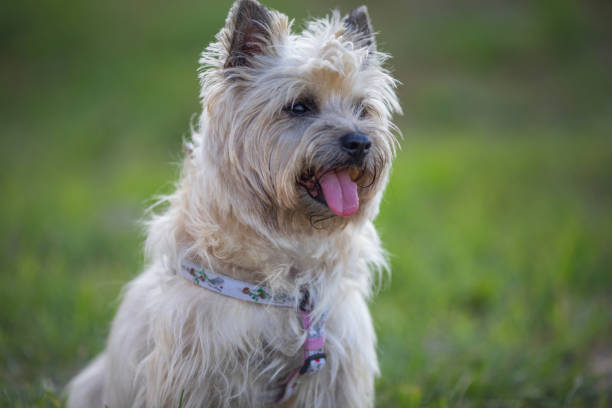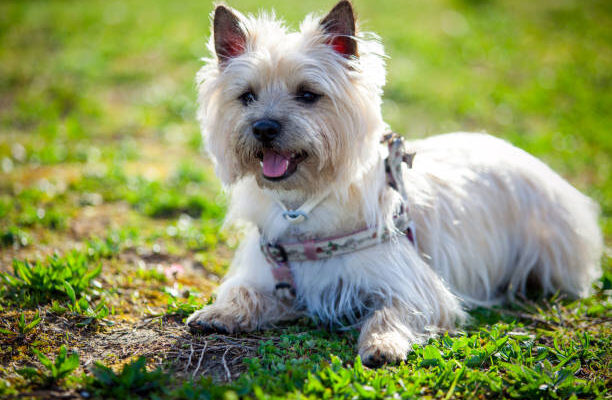The Cairn Terrier originated from its Scottish Highland work roots to become an outgoing friendly companion which now accepts families globally. With their fox-like appearance and active ways and expressive eyes the Cairn exhibits an ideal mixture of explorative personality and love for others. The complete information about Cairn Terriers’ existence runs from their original origins through their care routines and functional requirements up to their daily life routines for a comprehensive understanding of their fascinating breed characteristics.
Table of Contents
- Introduction to Cairn Terriers
- History and Origin
- Physical Characteristics
- Personality and Temperament
- Training a Cairn Terrier
- Exercise and Activity Needs
- Nutritional Requirements and Diet
- Grooming and Hygiene
- Common Health Issues and Preventive Care
- Socialization and Behavior
- Living Conditions and Adaptability
- Fun Activities and Games
- Conclusion
Introduction to Cairn Terriers
Smaller in dimensions the Cairn Terrier manifests large character traits. The dogs who were first created from Scottish wilderness to extract foxes from rock countries possess ongoing intense attitudes and courageous characteristics. Their heritage from working life should not hide their capacity to make loyal and affectionate companions who form deep bonds with their human family. A Cairn completes its look with a shaggy weather-resistant coat and expressive bright eyes which make it instantly noticeable and universally endearing.
History and Origin
Scottish Roots and Working Heritage
The Cairn Terrier hails from the Isle of Skye and other parts of the Scottish Highlands. Small agile working dogs with exceptional burrow-hunting skills needed to exist in rough mountain terrains for the purpose of trapping foxes while flushing out badgers. The breed acquired its name through its habit of searching for rodents and small animals that took refuge at burial sites marked by cairns.
Development and Recognition
Cairn Terriers are counted among the oldest terrier breeds to exist. The Cairn Terrier comes from lineage which also produced the Scottish Terrier and West Highland White Terrier as well as the Skye Terrier. Before the early 1900s these terriers existed as one unclassification until separate breeding and official standards created distinct terrier types.
Fun Fact: The Cairn Terrier achieved worldwide popularity after Terry the female dog played the movie role of Toto in The Wizard of Oz (1939).
Physical Characteristics
Size and Build
- Height: 9.5–10 inches (at the shoulder)
- Weight: 13–14 pounds
- Build: Compact, sturdy, and well-muscled
Cairns may look scruffy, but they’re tough and agile. Their small size hides their strong legs and deep chests, perfect for their original working roles.
Coat and Colors
Cairns have a double coat:
- Outer Coat: Harsh and weather-resistant
- Undercoat: Soft and insulating
Color Variations:
- Cream
- Wheaten
- Red
- Gray
- Brindle
- Black (though rarely solid black)
Their coat often changes shade slightly as they age.
Personality and Temperament
What Is a Cairn Terrier Like?
Cairn Terriers show traits of curiosity together with intelligence and fearlessness. Their high spirits easily enhance every home along with their distinguishing characteristics that include:
- Playfulness
- Quick reflexes
- Problem-solving ability
- Independence
These dogs are natural-born explorers and will investigate every corner of your home and yard.
Are Cairn Terriers Good Family Dogs?
Cairn Terriers work as ideal household pets for families that have children past the age of silliness. These dogs express affection without being overprotective so they work well for families together with singles and elderly adults seeking active friendship.
Are Cairns Good Guard Dogs?
Although Cairns lack actual guarding abilities their natural watchdog instincts make them valuable protectors. These dogs both listen and notice their surroundings with a habit of using barking to signal external sounds and visitors.
Training a Cairn Terrier

Intelligence and Trainability
Cairn dogs maintain high intelligence levels at the same time as displaying determined characteristics. These dogs learn quickly however they will only do so when learning brings them interest. Positive reinforcement is essential.
Training Tips:
Begin training and socialization early
You should employ treats together with praise and toys to reward your Cairn Terrier for their good actions.
Keep sessions short and upbeat
Using harsh correction methods with Cairns can create two possible negative reactions: rebellion and loss of interest.
Socialization
Start exposing your Cairn Terrier to new people and pets and environmental situations as well as differing encounters during its early life stage. Socializing your Cairn Terrier minimizes the chances of barking problems as well as behavioral or territorial issues.
Exercise and Activity Needs
Daily Exercise Requirements
Cairns maintain their energy level even though their small size. Each day your Cairn Terrier requires at least 60 minutes of exercise during multiple divided sessions.
Physical Activities:
- Walks and hikes
- Off-leash play in secure areas
- Fetch and tug-of-war
- Canine sports like agility or earthdog trials
Mental Stimulation
Cairns are thinkers. A bored Cairn Terrier tends to dig the ground while vocalizing and taking bites of furniture and finds ways to exit the yard.
Mental Activities:
- Puzzle toys
- Obedience tasks
- New trick challenges
- Hide-and-seek with treats or toys
Nutritional Requirements and Diet
Recommended Diet
The Cairn Terrier needs a protein-rich high-quality diet to thrive. Search for dog food that starts with animal meat and exclude ingredients like corn and soy from the list.
Good Ingredients:
- Chicken, turkey, or lamb
- Sweet potatoes and brown rice
- Fish oils (for coat health)
- Blueberries and pumpkin
Feeding Schedule
- Puppies: 3–4 small meals per day
- Adults: 2 meals per day
Measure portions carefully to prevent obesity, and always provide clean, fresh water.
Grooming and Hygiene
Grooming Routine
Cairns have non-matting hair but owners need occasional care to keep the coat looking its peak.
Routine Needs:
- Brushing: 2–3 times per week
- Hand-stripping: Every few months for show dogs
- Bathing: Every 6–8 weeks
- Nail trimming: Every 2–3 weeks
- Ear cleaning: Weekly
- Dental care: 2–3 times per week
Coat Maintenance by Type
Despite identical coat types all Cairn Terriers exhibit minor differences in their texture between individual breeding lines. This type of coat defended them from dirt accumulation because of its rough texture thus reducing grooming effort in rainy conditions.
Common Health Issues and Preventive Care
Common Health Conditions
Cairns are generally healthy, but they can be prone to a few breed-specific conditions:
- Craniomandibular Osteopathy (CMO): Jaw swelling in young dogs
- Legg-Calvé-Perthes Disease: Hip joint problem
- Allergies and skin issues
- Hypothyroidism
- Ocular issues like cataracts
Preventive Care Tips
- Schedule annual veterinary checkups
- Keep up with flea, tick, and heartworm prevention
- Watch for changes in skin or coat
- Feed a balanced, high-quality diet
- Stay up to date on vaccines and microchipping
Socialization and Behavior
Tips for Socializing Your Cairn Terrier
You should let your puppy meet different people along with animals at an early age
Your Cairn Terrier should enroll in puppy kindergarten and training courses.
Take your dog with you whenever you go out in your car as well as when you go public.
Rewards serve as the most effective teaching tool when introducing your dog to new situations.
Common Behavioral Traits
- Energetic: Constantly on the move or looking for fun
- Alert: Quick to react to sounds or strangers
- Affectionate: Loyal to family, though not overly clingy
- Territorial: Will defend space from unfamiliar animals
- Independent: Has a mind of their own
Living Conditions and Adaptability
Best Living Environments
Cairns are incredibly adaptable dogs. They do well in:
- Houses with fenced yards
- Apartments (with daily exercise)
- Rural or suburban areas
The key is not space—it’s stimulation. A Cairn in a small apartment with lots of activity will be happier than a bored Cairn on a big farm.
Climate Sensitivity
- Cold: Their double coat provides some insulation, but jackets are helpful in extreme cold.
- Heat: Avoid excessive sun and heat. Make sure shade and water are always available.
Fun Activities and Games
Physical and Mental Games
Exit games which enable digging or chase play or mental stimulation make Cairns completely happy.
Great Activities:
- Fetch: Especially with plush toys
- Tug-of-war: Builds bonding and tires them out
- Agility training: Use jumps, tunnels, and weave poles
- Scent work: Hide treats in snuffle mats or around the house
Enrichment Tools
- Food puzzles and treat balls
- Hide-and-seek toys
- DIY digging boxes with toys hidden in sand or blankets
- Trick training challenges
Conclusion
A petite well-built Cairn Terrier carries within itself both strength and charisma with along with vibrant personality traits. Cairn Terriers need this energetic lifestyle so they demand homes that allow active living yet owners receive unfailing friendship together with continuous enjoyment through their lifetime partnership.
Key Takeaways:
The Cairn Terrier breed expresses its intellectual nature through bold character and adventurous spirit because it seeks mental stimulation and physical activity.
The weatherproof coat of Cairn Terriers remains straightforward to care for through regular brushing in combination with strip therapy sessions.
Prosperous puppyhood and socialization techniques will produce a balanced temperament.
Cairns find their best quality of life in households that keep them occupied with daily exploration and playtime through active outdoor activities.
With proper care and affection the Cairn Terrier will become your faithful and entertaining pet that will accompany you for numerous years.




